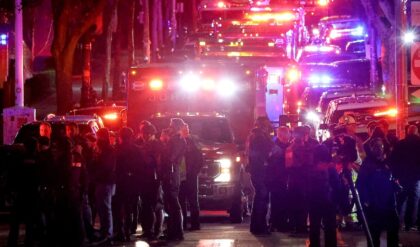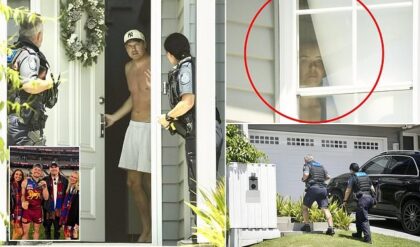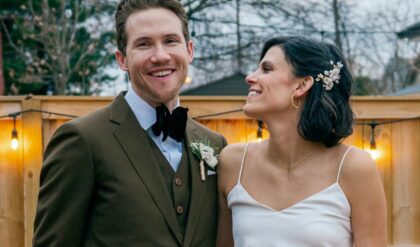
Jodie Foster as Detective Liz Danvers and Kali Reis as Detective Evangeline Navarro.HBO
Dark secrets lay deep below the icy surface in HBO’s detective anthology drama True Detective: Night Country. Set in the frigid fictional town of Ennis, Alaska, the show follows officers Liz Danvers (Jodie Foster) and Evangeline Navarro (Kali Reis), who team up after a group of scientists vanish in the middle of the night and are then found dead with their frozen bodies entangled in the snow. The investigation of their death leads the pair to unearth a conspiracy in a network of ice tunnels. Here, production designer Daniel Taylor talks to Deadline about how he conceptualized the dark secrets and chilly caverns in Iceland to portray a small town in Alaska.
DEADLINE: You met Issa López on a British production some time ago, right? And then she referred you to True Detective?
DANIEL TAYLOR: Exactly. I work with her on a Sky Atlantic show, and she came in and did a couple of episodes and we hit it off. I had to build a really big set for her, this two-tiered gallery Game of Thrones kind of hall, which was amazing fun. Because we got on really well, she was like, “Listen, there’s a chance that True Detective might be happening. I’m writing the show, running, directing. Do you want to be in?” And I’m like, “Yep, that’d be quite cool, thanks.” Over here [in the U.K.], I know True Detective has a huge following in the U.S., but it’s as big here as it is over there. It’s got an extraordinary presence in terms of a high watermark of filmmaking. So having or being given the opportunity to meet her for it, meet the producers for it, meet HBO for it was a chance in a lifetime, really.
DEADLINE: When you got the script, how did you interpret that in your mind? Did you get inspired by some music first or Pinterest mood boards?
TAYLOR: When I first read it, I was so blown away by the story and that I was even being associated with a show of this size and level of ambition that I had to put it down again and just maybe come back it a few days later because it was such a big thing to process like, where the fuck are we going to shoot this? How the fuck are we going to shoot this? It is an extraordinary kind of story that comes off the page, and she’s so talented at developing the world in terms of when you’re reading the stage direction and the dialogue.

Ice Cave concept boardsHBO/Daniel Taylor
It took me a long time to start to process the process. I just was like, this is something that I haven’t done before. I haven’t even come close to doing something like this. This is proper world-building in another country to double for another country. I don’t know Alaska, I don’t know Iceland so I’ve got to build Alaska in Iceland, and I’m from London. It’s just referencing and researching. So, then there’s weeks and weeks and weeks of pulling out all of these images of photographers that you really respond to that work in these conditions or it might be you’re speaking to the people from the indigenous community. I mean, we went to those places. We went to Nome and Kotzebue and thought, “How are we going to make our Ennis?” So we went to Alaska, and then we went to Iceland on a kind of fact-finding mission. Can we recreate Alaska in these parts of Iceland? Does this work?
There’s lots of other factors, too, right? How available is everything? Is there a competent film community? I mean, in Iceland, there is an established kind of film base there, in Northern Alaska, less so. The temperatures are a lot harsher. In Alaska, it drops down to 40 below Celsius, whereas in Iceland, it’s only 5 to 10, so generally, you can work in those conditions, but you can’t in -40; the batteries don’t last for the cameras. It will just ruin everything. So, it was a little bit of referencing, researching with books, Google and fact-finding missions to those places to take baby steps in order to build the world.
We knew Ennis would be about 8,500 people, Kotzebue was 3,500 people, and Nome was a little bit bigger. So, I physically took one and took the other, put them together, put them on the coast that suited our story a little bit further north than actually Nome is. And then, very quickly, we started assembling a town, then pulled the people in, and then understood that Navarro is a loner and she wants to be out of town, and Danvers is in the middle by the police station. And then, very quickly, we started building this town where everybody lives. And so, I was very keen to bring everybody along, including the crew and the cast, with this town I’d created. On the wall, I literally had a map to understand where we were in the world, where the town is in the country and where the people live in relation to everybody else. It was the most fun process.

Detective Danvers (Foster) and Detective Navarro (Reis) breaking through the underground ice tunnelsHBO
DEADLINE: What were some challenges with building sets in Iceland while trying to make them look American?
TAYLOR: There’s two parts to this question. There’s a logistical part, which was complicated because things like the plug sockets, the light switches, the radiators and European fridges are very different from fridges in the U.S. typically. So, there’s a lot of stuff that I felt like I was tasked with getting right. I imagine there are huge amounts of Alaska that most people from the U.S. generally haven’t seen. I felt like there was honesty and truthfulness for my department and me to make it as right as possible. So, every time you go into an interior, you have to take the radiators out and change all the plug sockets and the light switches. That’s a headache everywhere you go. And then you have to put them back when you move out of the house.
Most of the locations were very Icelandic in terms of their interiors, and we wanted to have a slightly more nineties and tired U.S. feel. So, all the interiors we were shooting as locations needed to be repainted, repapered, and reinstated when we left. All of the light fittings needed changing. So, it was complicated in that respect. But to be honest, that is always the situation. Whenever you kind of go into filmmaking that’s largely location-based, you’re going to have these complications. We had to treat True Detective like a period movie because you have to change everything. You have to change the lot, whether it is the action vehicles or the signage on a billboard or the light fitting, everything, the whole thing needed to be switched out. And the producers were super understanding of that and made sure that our budget could reflect the level of detail we wanted.
There were so many fucking amazing people working on this, and the photography team of Dana Lixenberg, Jen Kinney, Mark Mahaney, Brian Adams and Todd Hido was outstanding. They’re super good. Sarah Ayagi Whalen Lunn ended up coming on board as our indigenous artist. So, she did a lot of the graffiti and artwork around and in people’s homes. She’s an Inupiaq artist living in Anchorage; she’s a fucking genius, that lady. In the show, what we wanted to try and do is, in some of the scenes where there was a deep level of trauma or upset, what I wanted to try and do is have some graffiti art very close by or in an earlier scene as a precursor for the audience to try and get them to start to feel a certain emotion before you are then hit by that performance. There were some really beautiful pieces of artwork that we had painted on the side of a container, on the side of a bin, just a couple of scenes before a real gut punch, and I just think it preps the audience into getting into that emotional state before the performance comes in.
I think that’s really important because part of my work as a production designer is a lot more psychological. We want to enhance the narrative with composition with lighting, set design, but really prepping the audience to feel something when they watch it and Sarah helped do that.
DEADLINE: I’d be remiss if I didn’t mention the ice caves. How did you approach building those?
TAYLOR: The ice caves were quite a complicated set, not only in their construction, but in the previsualization stage. So, what we did was read the dialogue and work out how long our ice caves needed to be to sustain that level of dialogue and then retrofit the design to the length of dialogue in that scene. We knew we needed to get Jodie and Kali from the outside and we needed to get them down to the laboratory. So, we needed to make the ice caves work to join the two set pieces. We wanted the first cave they break through to be small, little and a bit of a struggle. And then as they get into the more established tunnel, they become slightly larger. So, what we did is, I’ve got a guy named Greg Shaw, who specializes in 3D models. He works in Unreal Engine, the game engine. So, he built the ice caves in the game engine; that way, we could go down there ourselves by putting the 3D VR headset on. This was great because it gave a better understanding of proportion and ceiling height and when you want the tunnels to open up.

Detectives Danvers (Foster) and Navarro (Reis) exploring the underground ice tunnelsHBO
Once we worked out how to do everything, because we couldn’t just have all of that as one long tunnel, we sectioned it off into three or four different bits. We built bits up on a roster so they could fall through. The ice cave, the bone chamber, was up on a roster because we had the arm, the ice core drilling machine tripped down as it went into the abyss. All of this was so advanced in the previous stage, and then we got to the actual building bit, and we just started heating bits of 8×4 sheets of plastic and gluing it together. It was a high-concept pre-visualization, and then there was this very theatrical kind of scissors, string, and sellotape thing for the actual delivery of the set.
DEADLINE: What is it like to build an ice cave when you’re already in Iceland, though? I’m guessing the Icelandic crew were probably very confused about why you’d bother building one, when you could film in a real one.
TAYLOR: Yeah, to be honest, I was like, “Guys, we’re in Iceland. There are ice caves here. Can we not shoot an ice cave?” Because part of me was a little bit scared about delivering a convincing ice cave. I hadn’t seen one that’s been built before. I was a little bit nervous that we may not deliver this and that it may not be good enough. I worried because I lost sleep thinking about how we were going to fabricate this environment. But it became very apparent very quickly with the amount of dialogue and the fact that we had Jodie and Kali down there for so long while moving a camera around into small spaces; it was very complicated. The build allowed us to take sections out. So, you could be going a bit more profiling with them then you can bring the wall in, you could go further back and have them walking towards you. Because the sequence was a little bit more complicated in terms of how we wanted to photograph it, it required us to think a little bit more traditionally in terms of a set build and what it needs to do, how many moving parts it needs to have.
So once we’d realized how to build it, everybody came on board, and we were shooting up north and building in the south, so we kept sending samples up north so that crew could figure out how to light the set and dress it so that Issa could see it before they were going to shoot on it so that she could approve in terms of its final finish. It was complicated in that aspect, but it was so good and effective. The Icelandic guys were like, “Oh my God, this is just another thing that we can do now. People can come over and really shoot in the ice caves, or we can build ice caves for them.” I mean, I turned up one weekend just before we were shooting just to double-check the dressing and have a quiet moment in the ice caves myself. The construction manager had brought his neighbor in, and it was like a theme park ride. There were groups of people walking through the ice cave and everybody was like, “Oh my God, this is so convincing.” So, it ended up being quite the attraction.



